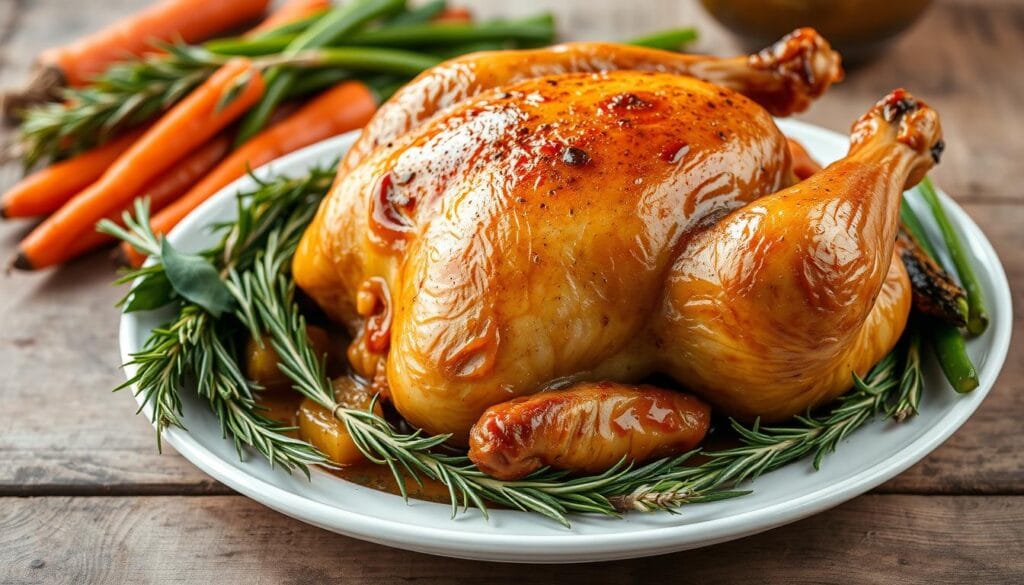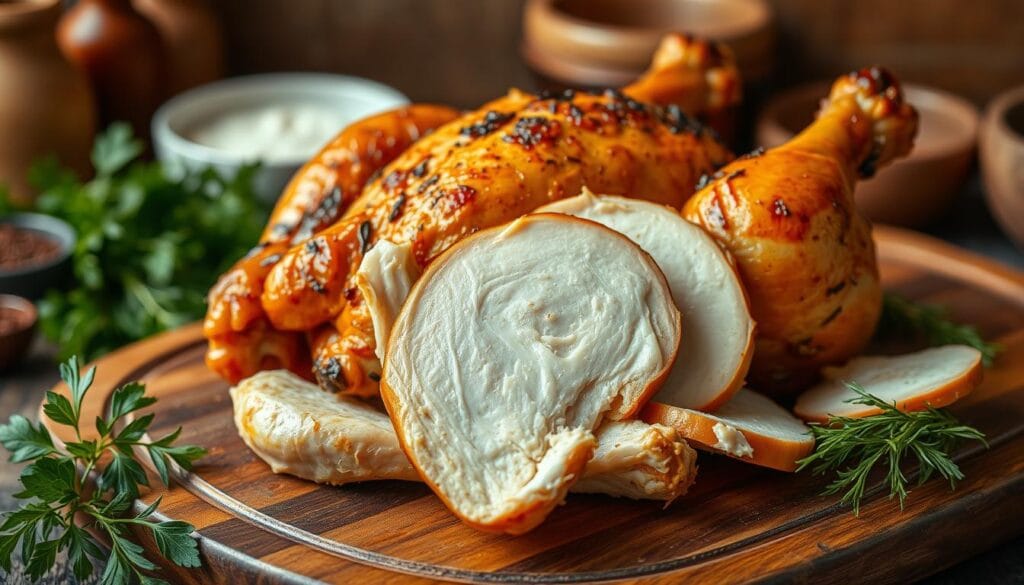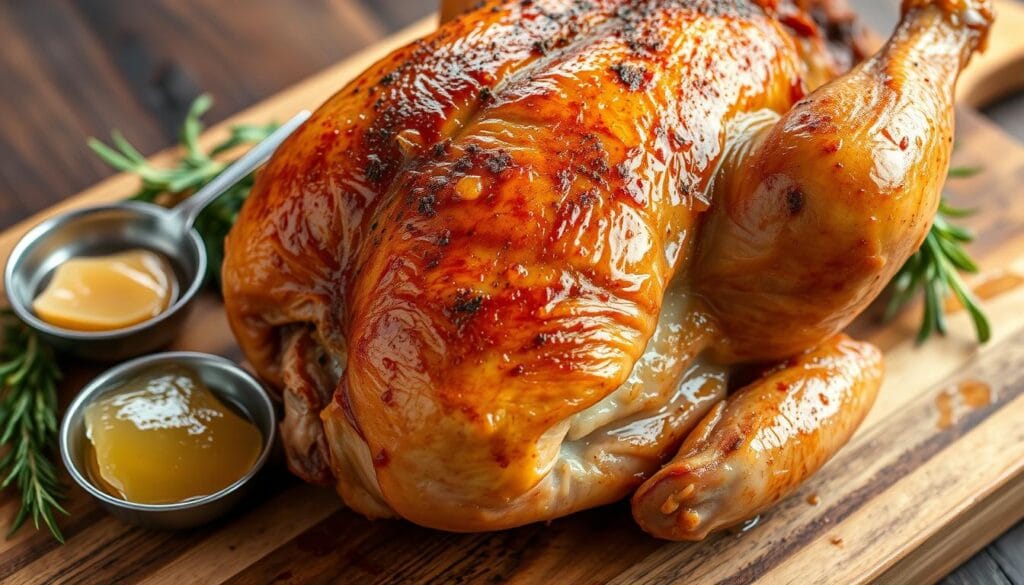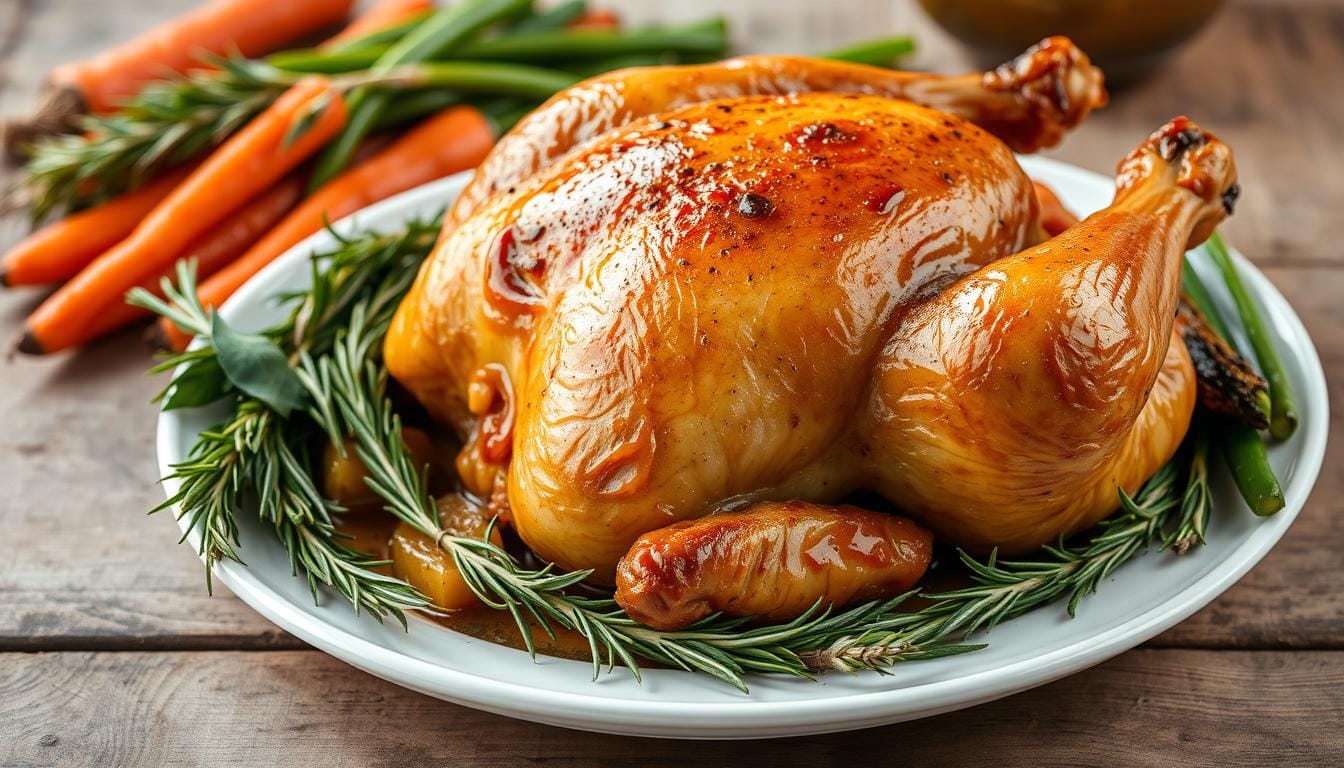Rotisserie Chicken Nutrition Facts: Calories, Protein, and Health Benefits
Rotisserie chicken is a tasty and healthy meal choice. It’s a great alternative to fried chicken. This cooking technique keeps the meat moist and tender. It’s perfect for quick weeknight meals or weekend gatherings.
A 3-ounce portion of rotisserie chicken contains 18 to 24 grams of protein. The calories range from 122 to 192, depending on the cut and if you eat the skin.
Rotisserie chicken is also packed with important nutrients. It has niacin, selenium, riboflavin, vitamin B12, phosphorus, and zinc. These nutrients help with energy, immune function, and repairing tissues. It’s a great choice for those who are active, need muscle recovery, or just want a tasty, healthy meal.

Table of Contents
Understanding Rotisserie Chicken Nutrition
Rotisserie chicken is a favorite in many grocery stores in the U.S It’s cooked on a rotating spit for even heat. This makes the skin crispy and golden. But, what makes it special, and how can you choose a healthier option?
What Makes Rotisserie Chicken Different
The rotisserie method is unique. Unlike baking or frying, it uses a spit to self-baste the chicken. This keeps it juicy and flavorful with a crispy skin.
Cooking Process and Preparation
Rotisserie chickens are seasoned with garlic, onion powder, salt, and pepper. The seasoning and rotisserie heat create the chicken’s signature taste and texture.
Store-Bought vs Homemade Options
Store-bought rotisserie chicken is convenient, but watch the ingredients. Many have preservatives and additives. Making it yourself lets you select healthier ingredients.
Rotisserie chicken can be healthy and affordable if you pick the right one. Knowing how it’s made and what’s in it helps you enjoy its taste and benefits.
“Rotisserie chicken is an excellent choice for a quick and easy meal, but it’s essential to choose versions with clean, simple ingredients to get the most health benefits.” – Brandy a Licensed and Registered Dietitian
Nutritional Value Per Serving
Rotisserie chicken is a favorite for many, but what’s in it? Let’s look at the rotisserie chicken nutrition. We’ll cover rotisserie chicken calories and rotisserie chicken protein.
A 3-ounce serving of rotisserie chicken breast without skin has about 122 calories. It also has 24 grams of protein and 3 grams of fat. In contrast, a 3-ounce serving of rotisserie chicken thigh with skin has 192 calories. It has 18 grams of protein and 12 grams of fat.
| Nutrient | Chicken Breast (3 oz, no skin) | Chicken Thigh (3 oz, with skin) |
|---|---|---|
| Calories | 122 | 192 |
| Protein (g) | 24 | 18 |
| Fat (g) | 3 | 12 |
Rotisserie chicken is packed with good stuff like B vitamins and minerals. It has niacin (30-51% of the daily value) and selenium (33-36% of the daily value). It also has phosphorus (15-17% of the daily value). The exact rotisserie chicken nutrition depends on the cut and if you eat the skin.
Knowing the rotisserie chicken calories and rotisserie chicken protein helps you make smart choices. This way, you can add this versatile protein to your diet and reach your health and fitness goals.
Protein Content and Muscle Health Benefits
Rotisserie chicken is packed with complete protein, giving your body all the amino acids it needs. A 3-ounce serving has 18-24 grams of high-quality protein. This supports muscle growth, repair, and body function.
Complete Protein Profile
Chicken is a complete protein because it has all nine essential amino acids. Your body can’t produce these on its own, making rotisserie chicken a great choice for muscle health and growth.
Role in Muscle Development
The protein in rotisserie chicken is key for hormone regulation and blood sugar control. It also helps repair and maintain muscle tissue. Protein digests more slowly, helping you feel full and supporting weight management.
Daily Protein Requirements
- The daily protein need is 0.8 grams per kilogram of body weight. For a person weighing 150 pounds, that’s approximately 56 grams.
- A 3-ounce serving of rotisserie chicken gives almost half of what an average adult needs daily.
- Eating rotisserie chicken as part of a balanced diet helps meet your daily protein needs. This supports muscle health and overall well-being.
“Rotisserie chicken is a great source of complete protein, offering all the essential amino acids your body needs for muscle growth and repair.”
Calorie Breakdown: White Meat vs. Dark Meat
Rotisserie chicken has different calorie counts for white and dark meat. Knowing this helps those watching their calories or looking for a healthier chicken choice.
White meat, like the breast, has fewer calories and fat than dark meat, like the thighs. A 3-ounce breast without skin has 122 calories and 3 grams of fat. On the other hand, a 3-ounce thigh with skin has 192 calories and 12 grams of fat.
For those watching their rotisserie chicken calories, white meat without skin is the lowest-calorie option. It’s great for those trying to lose weight or live a healthier life.
| Cut | Calories per 100g Serving | Protein (%) | Fat (%) |
|---|---|---|---|
| Chicken Breast | 284 | 80% | 20% |
| Chicken Thigh | 208 | 55% | 45% |
| Chicken Wing | 203 | 64% | 36% |
| Chicken Drumstick | 155 | 65% | 35% |
Knowing the calorie differences between white and dark meat helps you choose better when eating low-calorie rotisserie chicken. You can adjust your portions to fit your diet.

Essential Vitamins and Minerals
Rotisserie chicken is more than just a tasty meal. It’s also full of vitamins and minerals that boost your health. It has B vitamins, selenium, and zinc, making it a great addition to your diet.
B-Vitamin Complex
Rotisserie chicken is rich in B vitamins like niacin, riboflavin, and vitamin B12. These vitamins help your body make energy, keep nerves healthy, and make red blood cells. They’re key to keeping your body running well.
Mineral Content
It’s also packed with minerals like selenium, phosphorus, and zinc. Selenium helps your thyroid and protects cells. Phosphorus and zinc are good for bones and keeping you healthy.
Nutritional Benefits
The vitamins and minerals in rotisserie chicken are great for your health. They help you feel more energetic, keep your skin and hair looking good, and improve your brain function. They also boost your immune system and help your bones stay strong.
- Boost energy levels and combat fatigue
- Support healthy skin, hair, and nails
- Enhance cognitive function and mental clarity
- Strengthen the immune system and fight off infections
- Promote healthy bone development and maintenance
Looking to boost your energy or add more nutrients to your diet? Rotisserie chicken is a fantastic choice. It offers many health benefits for an active lifestyle.
Fat Content and Dietary Considerations
Rotisserie chicken’s fat content varies by cut and whether you eat the skin. Breast meat without skin has about 3 grams of fat per 3-ounce serving. Thigh meat with skin can have up to 12 grams of fat. Cutting off the skin reduces saturated fat in breast meat by half and in dark meat by a third.
The American Heart Association suggests keeping saturated fat below 5-6% of daily calories. For a 2,000-calorie diet, that’s about 13 grams of saturated fat per day. Rotisserie chicken can be a healthy option, but watch the fat content, especially if you’re controlling your fat intake.
| Chicken Cut | Fat Content (per 3-oz serving) |
|---|---|
| Breast (skin removed) | 3 grams |
| Thigh (skin on) | 12 grams |
Choosing the right cuts and removing the skin makes rotisserie chicken a tasty and healthy choice. It helps you manage your rotisserie chicken fat content and stay on track with your diet.

Sodium Levels and Health Impact
Rotisserie chicken nutrition is important, especially when it comes to sodium. The sodium in rotisserie chickens can vary a lot. This is because some chickens are brined or heavily seasoned, which adds a lot of sodium.
Understanding Sodium Content
A 3-ounce serving of rotisserie chicken has about 440-450 mg of sodium. This is about 19-20% of what we should eat daily. The average American eats way more sodium than they should, around 3,400 mg a day.
Managing Sodium Intake
To keep your sodium intake healthy, watch how much rotisserie chicken you eat. Choose lower-sodium options or remove the skin to cut down on sodium. You can also eat other proteins like grilled chicken, fish, or plant-based options that have less sodium.
Knowing about the sodium in rotisserie chicken helps you enjoy it without harming your health. By making smart choices, you can enjoy its taste while keeping your sodium levels in check.
“Excess sodium intake can lead to short-term effects like puffiness and bloating, as well as long-term health conditions like kidney disease, osteoporosis, and hypertension.”
Storage and Food Safety Guidelines
Keeping your rotisserie chicken fresh and safe is key. Here are some tips to enjoy your chicken to the fullest:
Put leftover chicken in an airtight container in the fridge for 3-4 days. For longer storage, freeze it for up to 4 months, as the USDA suggests. Always heat the chicken to 165°F (74°C) before eating to kill bacteria.
Don’t let the chicken sit out for too long. Bacteria can grow in temperatures between 40°F (4°C) and 140°F (60°C). The CDC says over 1 million people in the U.S. get sick from bad poultry each year. To stay safe, carve the chicken before refrigerating for easier reheating and portion control.
FAQ
What makes rotisserie chicken different?
Rotisserie chicken is cooked in the oven on a rotating spit. This ensures even cooking and crispy skin. It’s a healthier choice than fried chicken.
Is rotisserie chicken a healthy option?
Yes, rotisserie chicken is a nutritious meal. It’s packed with protein, vitamins, and minerals. The cooking method makes it better than fried chicken.
How many calories are in rotisserie chicken?
The calories in rotisserie chicken depend on the cut and skin. A 3-ounce breast without skin has 122 calories. Thigh meat with skin has 192 calories.
How much protein does rotisserie chicken provide?
Rotisserie chicken is a great source of protein. It offers 18-24 grams per 3-ounce serving. Protein is key for muscle growth and repair.
Is white meat or dark meat healthier in rotisserie chicken?
White meat (breast) is lower in calories and fat than dark meat (thighs). A 3-ounce breast without skin has 122 calories and 3 grams of fat. Thigh meat with skin has 192 calories and 12 grams of fat.
What vitamins and minerals are found in rotisserie chicken?
Rotisserie chicken is rich in B vitamins like niacin, riboflavin, and vitamin B12. It also has selenium, phosphorus, and zinc. These support the body’s functions.
How much fat is in rotisserie chicken?
The fat in rotisserie chicken depends on the cut and skin. Breast meat without skin has 3 grams of fat per 3-ounce serving. Thigh meat with skin has 12 grams.
How much sodium is in rotisserie chicken?
A 3-ounce serving of rotisserie chicken has 440-450mg of sodium. This is about 19-20% of the daily recommended intake. Sodium levels can vary based on preparation.
How long can I store leftover rotisserie chicken?
You can store leftover rotisserie chicken in the fridge for 3-4 days in an airtight container. For longer storage, freeze it for up to 4 months.
DID OUR INFORMATION HELP YOU ?
There are no reviews yet. Be the first one to write one.

